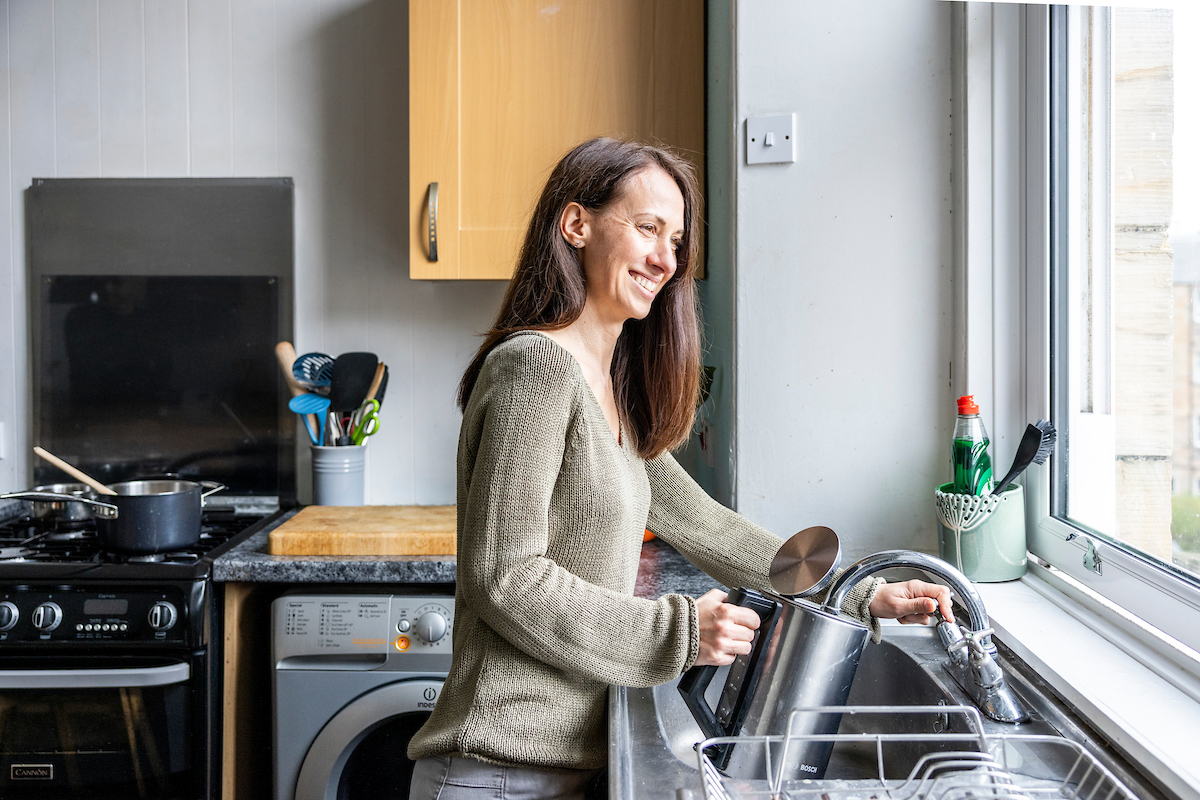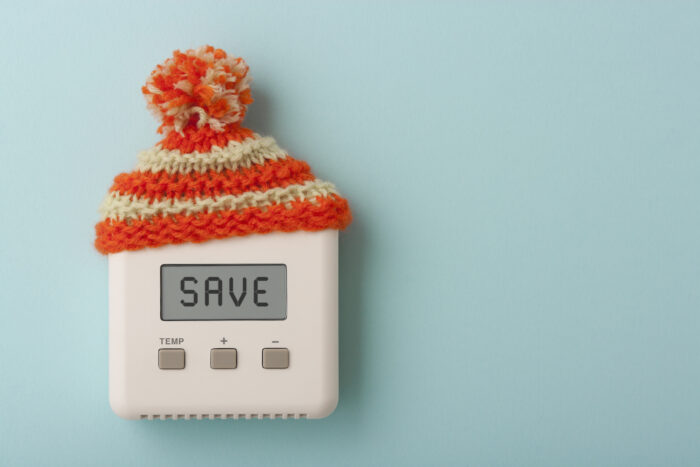Water Usage

Alongside room heating, most of the energy we use in our homes goes on heating water.
As a result, learning how to save on hot water means we can lower our energy bills and help Scotland reach its net zero target.
In most cases, your hot water will either come from:
- A hot water cylinder
- Your boiler
Hot water cylinder
In some homes, hot water is stored in a large cylinder. These are usually found in a large cupboard. You can think of a hot water cylinder as a very big kettle. The water inside is heated up and then sent out to your taps, shower, or anywhere else that hot water is needed. As the hot water from the cylinder is used, it’s replaced with cold water from your plumbing.
There are two different ways to heat the water in a hot water cylinder. It is also possible that your home has both options:
This is just like switching on your kettle. A heating element gets very hot and starts to warm the water around it.
An immersion heater runs on mains electricity.
The hot water cylinder has a hollow coil inside it. Your boiler heats up water to send through this coil. As the coil gets hotter, the water around it heats up as well.
Since it’s your boiler doing the heating, the fuel used to heat the water will be whatever fuel your boiler uses.
Whichever heating method your hot water cylinder uses, the temperature of the water is controlled by a thermostat. A thermostat senses the temperature of the air or water around it. You can set a thermostat to the temperature you want your water to be.
If the thermostat has been set to 60 degrees, then it will keep the water at that temperature. It does this by turning your boiler or immersion heater on when the temperature is too low, then turning it off again when the water temperature reaches the right level.
Choose the cheapest method of heating the hot water cylinder
If you have the option of using either the boiler or an immersion heater to heat the hot water cylinder, then you can work out which method is cheaper.
Firstly, if you have a smart meter, then try heating the hot water for half an hour using the immersion heater. Then, check how much this cost in electricity. The next day, rather than using the immersion heater, try heating the hot water with your boiler instead. Finally, check the cost and compare it with the immersion heater’s cost.
If your boiler uses gas, oil, or LPG, then it’s very likely that this is the most cost-effective way of heating your water. Using the immersion heater is the much more environmentally friendly option, but not everyone can afford to choose it.

Insulate your hot water cylinder
However you heat your hot water cylinder, you should insulate it as well as you can. Insulating the cylinder means that the water will heat up faster and stay warmer for longer. This helps to cut your energy costs.
You can buy hot water cylinder ‘jackets’ for around £20. These are quite easy to install yourself. They come with four separate panels which you place around the hot water cylinder, then tie together.
Choose a hot water cylinder jacket which is at least 80mm thick.
Make sure the hot water cylinder thermostat isn’t set too high
The thermostat on your hot water cylinder should be set between 60 and 65 degrees. Setting it any higher than this means you’re using more energy than is needed. Not only that, but you risk scalding yourself when using the hot water tap or shower.
You shouldn’t set your hot water cylinder thermostat any lower than 60 degrees. It needs to be this high to kill off legionella bacteria. Legionella is potentially fatal to humans, so it’s important to keep it out of your hot water.
Only heat the hot water twice a day
Whether you use your boiler or the immersion heater, you don’t need to constantly heat the hot water cylinder. This is because a well-insulated hot water cylinder should keep the water warm for at least a day.
Try heating the water for an hour in the morning and an hour in the evening. Start the water heating about an hour before you need it. For example, if you shower at 08:30, start heating the water at 07:30. If you wash up in the evening at 19:30, then start the water heating at 18:30.
On the other hand, if you heat the water using an immersion heater, then simply turn this on and off at your chosen times.
If you heat the water using your boiler, then use your programmer to set the water heating times.
- Make sure the hot water (the left-hand side of the programmer) is set to ‘twice.’ This means the boiler will heat the water at the times you set.
- Programme the hours you want the boiler to heat the hot water cylinder.
There are many different styles of programmer. If you’re not sure how to use your model, then try searching for videos on YouTube. Manufacturers and householders often upload helpful tutorials.
Controlling your water temperature
If you don’t have a hot water cylinder, then it’s likely that your hot water comes directly from your boiler. A boiler which provides both heating and hot water is known as ‘combi (combination) boiler’.
A combi boiler runs on gas, electricity, oil, or liquid petroleum gas (LPG).
The big advantage of a combi boiler is that you only heat as much water as you need. As a result, most of the ways to make savings involve using less hot water. You can find these in our Water Saving Tips section below, but first let’s look at a simple adjustment you can make on your boiler.
Lower your boiler’s flow temperature
A combi boiler heats up water to send to your radiators. It also heats up water to send to your hot taps. How high the boiler heats the water it sends out is known as the ‘flow temperature’.
A lot of combi boilers have their flow temperatures set too high. The ideal flow temperature for hot water is around 55 degrees, whereas for central heating, it’s between 50 and 60 degrees.
If either of your boiler’s flow temperatures are set higher than this, then your boiler is using more fuel than it needs to. Turning it down could save you around £65 on your energy bill, without impacting your comfort at all.
Take a look at our Saving energy in the home page for a step-by-step guide on turning down your boiler’s flow temperature.
As our friends at the Money Saving Boiler Challenge point out, if 10 million UK households followed this advice, then we’d save 1.7 million tons of CO2. That’s nearly six million flights from Scotland to the US.
Water saving tips
Whatever type of boiler you have, there are lots of others of ways to be efficient with hot water usage. Which of the tips below have you tried?
It only takes eight minutes (the average UK shower-time) for 60 litres of hot water to disappear down the drain.
Switching to a more energy efficient showerhead could help you save some of that water without cutting back on your cleanliness.
You can skip this section if you have an electric shower. With an electric shower, the flow rate is already likely to be quite low. For this reason, we wouldn’t recommend installing an energy efficient showerhead on an electric shower.
There are two main types of water-saving showerhead: aerating and non-aerating. Both reduce the amount of water flowing through the showerhead. The difference lies in how they manage to still deliver a satisfying shower.
Aerating showerheads – These mix air with the water coming out of the head. This means it still feels like you’re getting a decent water pressure whilst less water is being used.
Non-aerating showerheads – These have smaller holes. Less water goes through the head, but what comes through arrives at a higher pressure.
Upgrading your showerhead is relatively easy to do. Once you’ve bought a replacement, simply unscrew the old showerhead, then screw on the new one. If the showerhead is very old, you may need to loosen it with a spanner. If there are any leaks when you run the new showerhead, then patch these with plumbing tape.
We’ve probably all heard this one by now, but cutting your shower time – even just by a single minute – can lower your energy bills.
A shower-timer can help you keep track of how long you’ve been washing for. Alternatively, lots of people simply set an alarm on their phone. This has the added benefit of forcing you out of the shower to turn the alarm off.
The average Scottish bath holds around 180 litres of water. If we fill it just over halfway, we’re bathing in about 100 litres. That’s a lot of water to heat.
If you have the option of a bath or a shower, then the conventional wisdom is to switch at least one of your bath-days for a shower-day. However, this only saves hot water if you’re showering efficiently (see the advice above). Some modern showers – especially those which aren’t fitted with energy efficient heads – can easily get through 100 litres of hot water in ten minutes.
If you don’t have the choice of switching to a shower, a simple way to save is to make sure you only fill the bath with as much water as you need.
The average sink holds 15 – 18 litres of water. The average washing up bowl holds ten litres. Filling the bowl rather than the sink is an easy way to cut down on your hot water costs in the kitchen.
Running a tap for ten minutes will get through 100 litres of water, so try to keep rinsing dishes to a minimum.
If you have a dishwasher, then make sure it’s full before running a wash cycle.
Most dishwashers should have an eco-cycle, which runs at a slightly lower temperature. The eco-cycle typically uses about three litres less water than other cycles. This means a double-saving: less water and a lower temperature.
Useful pages
Is this page useful?